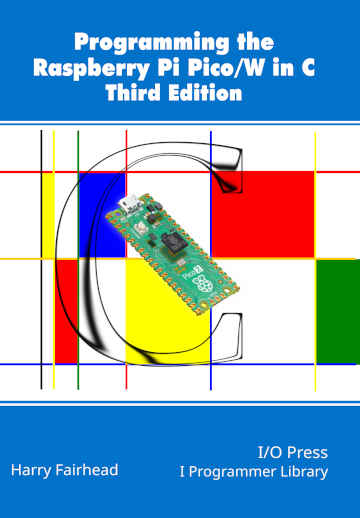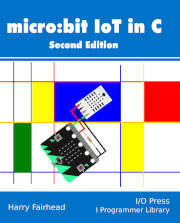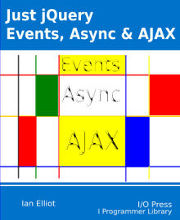Programming The Raspberry
Pi Pico/W In C
Third Edition
Program Listings
Errata
Resources
Second Edition Material
Buy from: Amazon
Reviews of the previous editions:
-
"One of the best programming books on microcontroller programming I have, and I have many"
-
"Often, these sort of books are just a rehash of the manufacturer documentation. This was written in a very clear style by someone who has actually used the Pico and encountered some of the traps and pitfalls. I would highly recommend this to anyone contemplating writing applications for the Pico in C/C++."
-
"As opposed to other books on the subject, this one goes deeply enough so that you can cover most aspects of what is discussed."
The Raspberry Pi Pico is a remarkable microcontroller. Its power and sophistication coupled with its low cost ensured its popularity. Now the second generation Pico with double the memory is consolidating its role as an excellent choice of microcontroller for home and industrial IoT.
This updated and expanded edition was prompted by the launch of the Pico 2 and Pico 2W which use a new chip, the RP2350, which offers significant improvements but also requires changes. This book therefore covers four devices, the new Pico 2 and its WiFi counterpart, the Pico 2W, as well as the original Pico and Pico W.
To take full advantage of the Pico there is no better language than C. It wastes none of the power and it gives access to all of its features. However, getting started with the Pico with C is no easy feat. You have to find a way to create programs and you have to set things up so that program testing and debugging is easy. Here we use VS Code as the IDE which is supported by the Pico VS Code extension, making the process much easier.
The purpose of the book is to reveal what you can do with the Pico's GPIO lines together with widely used sensors, servos, motors and ADCs. After covering the GPIO, outputs and inputs, events and interrupts, it gives you hands-on experience of PWM, the SPI bus, the I2C bus and the 1-Wire bus. One of the key advantages of the Pico is its PIO (Programmable I/O) and while this is an advanced feature it is introduced in this book. The PIO isn’t the solution to every problem, but it is very useful, challenging and a lot of fun. You will find out about the PIO in a dedicated chapter and then use it to implement a “driver” for the DHT22 and the 1-Wire bus. New in this edition is coverage of FreeRTOS – a realtime operating system that provides a way of organizing your program into asynchronous tasks. FreeRTOS also provides arguably the best way of utilizing both cores of the Pico2.
Harry Fairhead has worked with microprocessors and electronics in general, for many years and is an enthusiastic proponent of the IoT and embedded computing. He is the author of Master the Raspberry Pi Pico in C, which takes Pico programming to the next level. He has also written about the Raspberry Pi, most recently with Raspberry Pi 5 IoT In C: Drivers and Gpio5 and a companion volume for the Compute Module 5. His other books on the Raspberry Pi, the ESP32 and the Microbit have both C and Python versions. He has also written two machine-independent books on the C language, Fundamental C: Getting Closer To The Machine and Applying C For the IoT With Linux.
- Publisher : I/O Press (October 30, 2022)
- Language : English
- Paperback : 382 pages
- ISBN-10 : 187196279X
- ISBN-13 : 978-1871962796
- Item Weight : 1.82 pounds
- Dimensions : 7 x 0.87 x 10 inches
- ASIN : B0FDYDPQ54
- Publisher : I/O Press
- Accessibility : Learn more
- Publication date : June 19, 2025
- Edition : 3rd
- Language : English
- File size : 8.1 MB
- Publisher : I/O Press
- Publication date : June 20, 2025
- Language : English
- Print length : 417 pages
- ISBN-10 : 1871962366
- ISBN-13 : 978-1871962369
- Item Weight : 1.98 pounds
- Dimensions : 7.24 x 1.13 x 10.24 inches



